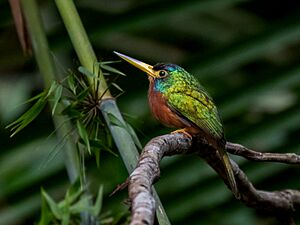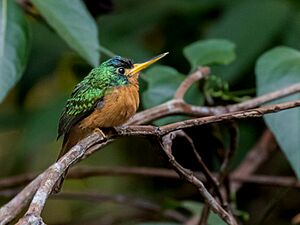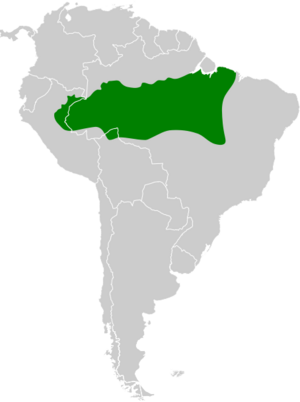Blue-necked jacamar facts for kids
Quick facts for kids Blue-necked jacamar |
|
|---|---|
 |
|
| male | |
 |
|
| female | |
| Conservation status | |
| Scientific classification | |
| Genus: |
Galbula
|
| Species: |
cyanicollis
|
 |
|
The blue-necked jacamar (Galbula cyanicollis) is a beautiful bird that lives in the forests of South America. It belongs to the Galbulidae family, which are known for their long, pointed beaks and shiny feathers. You can find these birds in countries like Brazil, Bolivia, and Peru.
Contents
About the Blue-necked Jacamar
The blue-necked jacamar is a unique type of bird. It is the only species in its group, meaning it doesn't have any subspecies. For a while, people thought it was the same as the yellow-billed jacamar. But since the 1970s, scientists have agreed they are different, though closely related.
What Does It Look Like?
The blue-necked jacamar is a medium-sized bird. It is about 19 to 22 centimeters (7.5 to 8.7 inches) long. It weighs around 21 to 26 grams (0.7 to 0.9 ounces).
Male and Female Birds
Male blue-necked jacamars have shiny green feathers on their upper bodies. Their undersides are a warm chestnut color. Their faces can look steely blue or green, depending on where they live. Female birds are a bit duller in color. Their undersides are a lighter, tawny buff color.
Where Do They Live?
You can find the blue-necked jacamar in South America. They live east of the Andes mountains and south of the Amazon River. Their home range includes eastern Peru, the very north of Bolivia, and parts of Brazil. In Brazil, they live as far east as Maranhão and south to Rondônia and northern Mato Grosso.
Their Forest Home
These birds prefer to live inside certain types of forests. They like "terra firme" forests, which are forests on higher, drier ground. They also live in "várzea" forests, which are forests that get flooded. You can often spot them in the lower parts of the forest, especially in small open areas. They also live in gallery forests, which are forests found along rivers in the "cerrado" (a type of grassland) of Brazil. They can live at elevations up to 900 meters (about 2,950 feet) high.
How Do They Behave?
Blue-necked jacamars have interesting ways of finding food and raising their young.
What Do They Eat?
The blue-necked jacamar eats many different kinds of insects. They are very good at catching flying bugs. They usually sit on an open branch, waiting. When an insect flies by, they quickly fly out to catch it in mid-air.
How Do They Breed?
Scientists have found blue-necked jacamar nests inside termite nests in trees in Brazil. These nests are like burrows dug into the termite mounds. Each nest usually holds two eggs. Birds ready to breed have been seen in September, and nests with eggs were found in June and October.
What Do They Sound Like?
The blue-necked jacamar's voice sounds very similar to the yellow-billed jacamar. You can listen to their song here: [1]. You can also hear one of their calls here: [2].
Their Conservation Status
The IUCN (International Union for Conservation of Nature) has looked at the blue-necked jacamar. They have assessed it as a species of "Least Concern." This means that the bird is not currently in danger of disappearing. It lives in several protected areas and is generally common across its range.
However, because this bird relies on healthy, untouched forest undergrowth, it might be more affected by deforestation than other types of jacamars. This means protecting their forest homes is important for their future.


